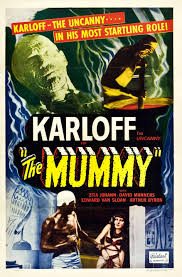
In 1921, an archaeologist, Sir Joseph Whemple (Arthur Byron), discovers the mummy of ancient Egyptian high priest Imhotep (Boris Karloff). Doctor Muller (Edward Van Sloan) observes that the viscera were not removed and the man seems to have been buried alive. Nearby is a casket with a curse written upon it. Despite warnings from Doctor Muller, Sir Joseph’s assistant Ralph Norton (Bramwell Fletcher) opens the casket and finds the Scroll of Thoth. He reads the words out loud and Imhotep rises from the dead. Norton promptly goes insane at the sight and Imhotep shuffles off with the scroll. Ten years later, Imhotep is an Egyptian historian named Ardeth Bey (Karloff again). He visits Sir Joseph’s son Frank (David Manners) and Professor Pearson (Leonard Mudie) and shows them where to dig for the tomb of Princess Ankh-Essen-Amun. The archaeologists donate the treasures found to the Cairo Museum and Ardeth Bey disappears.
Soon he discovers Helen Grosvenor (Zita Johann) a half-Egyptian woman who is the spitting image of the long-dead princess. He reveals that his horrible death was punishment for sacrilege—that is, trying to resurrect his lover, Princess Ankh-Essen-Amun. He believes that Helen is her reincarnation and he tries to kill her so he can mummify her and resurrect her, to make her his immortal bride. She recalls her past life and prays to the goddess Isis to help her. The statue of Isis raises its arm and a flash of light sets the scroll on fire, breaking the spell that gave Imhotep his immortality. He crumbles into dust. Frank calls Helen back to the world of the living.
The film was directed by Karl Freund, based on a screenplay by John L. Balderston, from a story by Nina Wilcox Putnam and Richard Schayer. It all happened after the world-famous opening of Tutankhamen’s tomb in 1922 and the supposed Curse of the Pharoahs. It was producer Carl Laemmle Jr. who commissioned the search for an appropriate story. They considered a short story by Sir Arthur Conan Doyle called The Ring of Thoth, but the story by Schayer and Putnam was chosen. Director Karl Freund had been the cinematographer on Dracula and Fritz Lang’s Metropolis. The real Ankh-Essen-Amun’s body had not been found in King Tut’s tomb and her burial place was unknown. Karloff’s makeup was again created by Jack Pierce. Makeup began at 11:00 AM and lasted until 7:00 PM, and Karloff’s scenes were finished at 2:00 AM. Then it took two more hours to remove it.
The film garnered mixed reviews and four Universal Studios sequels, in which the Mummy was played by Boris Karloff and Lon Chaney Jr. In the 1950s, Hammer Films made several more mummy films. An attempt to do the same in 2012, with Tom Cruise, was not successful. By and large, the historical background of the Mummy films was imaginary, though the Scroll of Thoth, who was the god of knowledge, was based on the Book of the Dead, and there is some evidence that someone in a conspiracy to assassinate Pharoah Ramesses II around 1150 BC was buried alive. But the real Imhotep was the architect who designed the pyramids, and he was not buried alive, he was the only non-Pharoah who was made a god. Movies often turn heroes into villains and vice-versa.
The opening theme music was Swan Lake, the same as that used in Dracula. When Howard Carter, for Lord Carnarvon, opened Tut’s sarcophagus, the reporter present for the New York World was John L. Balderston, who wrote the script for the Mummy. The other Mummy movies were not actually sequels, as they referred to a different ancient Egyptian named Kharis. Ardeth Bey is an anagram of Death by Ra. There are many reports that director Karl Freund was particularly cruel to actress Zita Johann. When she left Universal afterward, her billing for the Mummy was reduced from co-star to support player, though she loved working with Karloff. Freund later, working for I Love Lucy, invented the multiple-camera technique that made reruns possible. Jack Pierce was given a special makeup award by Boris Karloff for the “Hollywood Filmograph”. The plaque was thought lost until a sink was removed in a Universal studio renovation and there it was.
